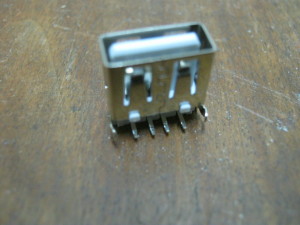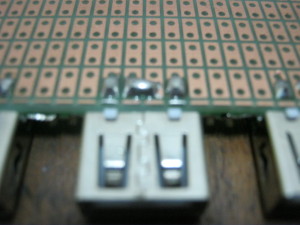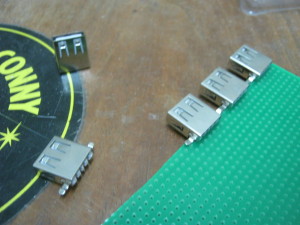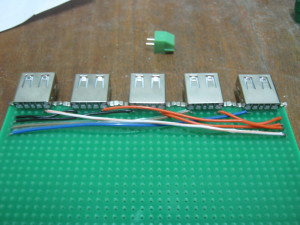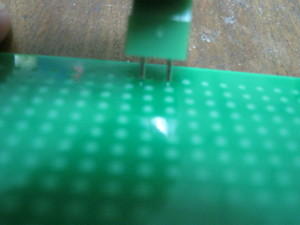I have been complaining about file system corruption on the SD card of my Raspberry Pi’s before. A suggested cause for this problem was a faultly power supply, delivering a too low voltage. Thinking about it, a faulty power supply might also be at the root of the stability issues I’ve always experienced with my BeagleBoard.
Jul 20 00:20:42 rpi kernel: [45414.541554] EXT4-fs error (device mmcblk0p5): ext4_ext_check_inode:462: inode #36100: comm pacman: bad header/extent: invalid eh_entries - magic f30a, entries 513, max 4(4), depth 0(0)
 Anyways, I’ve decided to try to power the Raspberry Pi with a fat power supply. A 5 Volt 6 Ampère power supply should not suffer from any voltage drops by the load of a Raspberry Pi, BeagleBoard or CubieBoard for that matter.
Anyways, I’ve decided to try to power the Raspberry Pi with a fat power supply. A 5 Volt 6 Ampère power supply should not suffer from any voltage drops by the load of a Raspberry Pi, BeagleBoard or CubieBoard for that matter.
 Apart from hooking up just an ARM board, there are more reasons for purchasing this power supply. Having a full extension socket with just power adapters that all output 5 Volts is just insane. It would be far more efficient to just have one supply to power all my devices, such as a network switch and USB hub. It could also be used to charge a phone. Think about it, a Raspberry Pi power supply is just a phone charger with Micro USB connector anyways.
Apart from hooking up just an ARM board, there are more reasons for purchasing this power supply. Having a full extension socket with just power adapters that all output 5 Volts is just insane. It would be far more efficient to just have one supply to power all my devices, such as a network switch and USB hub. It could also be used to charge a phone. Think about it, a Raspberry Pi power supply is just a phone charger with Micro USB connector anyways.
Since this power supply just outputs it’s 5 Volts on a terminal block I will of course have to fix some connectivity:
Since I am using regular female USB connectors, the part where I solder the connector itself to the PCB does not fit in my holes PCB, and I have to fold it away. The actual USB pins are soldered to the PCB. The middle pins are the data pins. I’ve short circuited the data pins to indicate being a charging port. (This is according to the USB specs.) I’ve connected some wires to the outer pins, being the plus and minus of the 5 Volt power pins. The idea was to solder some PCB terminal blocks, one to be connected to the power supply, and the others to provide power to devices, such as a network switch or my BeagleBoard, that require 5 Volt but come with some other power connected.
But then I discovered a problem. The distance between the pins of the connector blocks I’ve ordered is not an e-multiple. 1 e is 2,54 mm, a unit commonly used in electronics. It’s derived from American units (as 1 American inch is 2,54 cm) It is the distance between the holes on an PCB holes board. Components usually have a multiple of this. But not my connectors. So… a problem. Causing my little project to catch dust for several weeks.
 But thanks to Dean I’ve got some connectors that do fit by holes PCB, and I’ve continued my project. I’ve only wired two positions from my connector block, just hooking up the power supply. I’ve connected my Raspberry Pi, and a voltage meter to it now. This is just a prototype, far from the ideal situation I am aiming for. I want to built in some protection. Thinking about some over-voltage protection. I am using some cheap-ass Chinese power supply after all. Better safe then sorry, right? Same goes for over-current protection. When hooking all kinds of devices up, it might be wise. (P.S. I also have a 5 Volts 20 Ampère version…. a current like that could easily start a fire)
But thanks to Dean I’ve got some connectors that do fit by holes PCB, and I’ve continued my project. I’ve only wired two positions from my connector block, just hooking up the power supply. I’ve connected my Raspberry Pi, and a voltage meter to it now. This is just a prototype, far from the ideal situation I am aiming for. I want to built in some protection. Thinking about some over-voltage protection. I am using some cheap-ass Chinese power supply after all. Better safe then sorry, right? Same goes for over-current protection. When hooking all kinds of devices up, it might be wise. (P.S. I also have a 5 Volts 20 Ampère version…. a current like that could easily start a fire)
Anyhow, I got some 1 Ampère polyfuses. I suppose I could just put two of them in parallel to obtain a 2A polyfuse, right?

